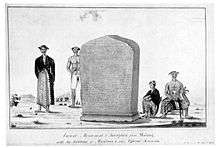Minto Stone
The Minto Stone or Stone of Sanggurah, known in Indonesia as Prasasti Sanggurah, is a 3 long tons (3.0 t), 2 metres (6.6 ft) tall stone tablet found in Malang, East Java province. In 1812, Sir Thomas Stamford Raffles, then Lieutenant-Governor of the island of Java, removed it along with the so-called "Calcutta Stone" as a token of appreciation to his superior, then British Governor-General of India, Lord Minto. It consequently became part of the Minto family estate near Hawick, Roxburghshire, Scotland.

The inscribed stone is dated to (2 August) 928 CE and mentions the name of a Javanese king, Sri Maharaja Rakai Pangkaja Dyah Wawa Sri Wijayalokanamottungga (Wijayaloka[1]), who then ruled the Malang area. The statement is a grant of rights (sima) to the local ruler and it ends with warnings to anyone wanting to uproot it, cursing that they would meet a horrible death (struck from all sides, beaten, nose cut, head split, liver ripped etc.).[2] According to Indonesian historians, the stone is an important artifact and a crucial source of information. It contains elements about the Mataram Kingdom in Central Java and the shift of power that consequently took place to East Java.[3]
Sri Maharaja Rakai Pangkaja Dyah Wawa Sri Wijayalokanamottungga is better known in Indonesia as Dyah Wawa (r. 924—929). He was the last ruler of Mataram. His successor, Mpu Sindok (r. 929—947), moved the court from Central Java to East Java in 929. The reasons for this move are still unclear.
Demands for the repatriation of the stone from Scotland to Java, in Indonesia, have been made since 2004.[4][5][6]
Sources
- Brandes, J.L.A. (1913). "Oud-Javaansche Oorkonden. Nagelaten Transscripties". Verhandelingen van het Bataviaasch Genootschap van Kunsten en wetenschappen. 60: 12-.
- Noltie, Henry (2009). Raffles' Ark Redrawn: Natural History Drawings from the Collection of Sir Thomas Stamford Raffles. London & Edinburgh: British Library & Royal Botanic Garden Edinburgh. pp. 19–20.
- de Longh, R.C. (1977). Handbook of Oriental Studies. Part 3. Brill. p. 55.
- "Javanese demand repatriation of Minto's stone of contention". The Southern Reporter. 6 February 2008. Retrieved 2011-02-28.
- "Indonesia demands historic stone back". The Scotsman. 4 February 2008. Retrieved 2011-02-28.
- "Ancient relic to return from Scotland". The Jakarta Post. 25 January 2008. Retrieved 2011-02-28.
Further reading
- Bastin, J., "Colonel Colin Mackenzie and Javanese antiquities", in Bijdragen tot de Taal-, Land- en Volkenkunde, 109 (1953), no: 3, Leiden, pp. 273–275